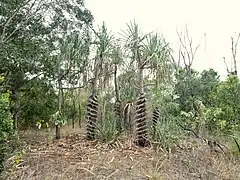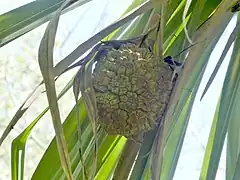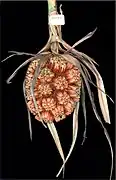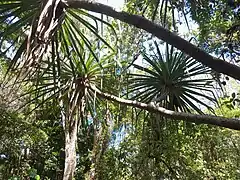| Cook's pandan | |
|---|---|
 | |
| Scientific classification | |
| Kingdom: | Plantae |
| Clade: | Tracheophytes |
| Clade: | Angiosperms |
| Clade: | Monocots |
| Order: | Pandanales |
| Family: | Pandanaceae |
| Genus: | Pandanus |
| Species: | P. cookii |
| Binomial name | |
| Pandanus cookii | |
| Synonyms[4] | |
|
List
| |
Pandanus cookii, commonly known as Cook's pandan, Cook's screwpine or simply screwpine, is a tree in the family Pandanaceae which is endemic to coastal and sub-coastal parts of tropical Queensland, Australia. It grows to around 10 m (33 ft) in height with an open habit, long narrow leaves up to 180 by 8 cm (70.9 by 3.1 in) and prop roots up to around 30 cm (12 in) long.[5]
Taxonomy
This species was first described by the Italian botanist Ugolino Martelli in a paper titled Le specie e varieta nuove di "Pandanus" menzionate nella enumerazione delle Pandanaceae. It was published in the journal Webbia in 1914.[6] Martelli's description was based on material collected in 1904 by a Mr. Dempsey near Cooktown.[5][6]
Etymology
The species is named after the English explorer Captain James Cook, who in 1770 was forced to spend some time in an inlet now known as the Endeavour River to repair his ship. The town of Cooktown was established on the banks of that river in 1873, and it was in this area that the type specimen was collected and provided to Martinelli.[5][lower-alpha 1]
Conservation
This species is listed by both the Queensland Department of Environment and Science and the International Union for Conservation of Nature (IUCN) as least concern.[1][2] In the statement supporting their assessment, the IUCN states "This tree species has a wide distribution and is not currently experiencing any major threats and no significant future threats have been identified. This species is therefore assessed as Least Concern."[2] The Queensland Department of Environment and Science has not provided a statement in support of its assessment.[1]
Gallery
 Habit
Habit Unripe fruit
Unripe fruit Ripe fruit
Ripe fruit Foliage
Foliage
References
- 1 2 3 "Species profile—Pandanus cookii". Queensland Department of Environment and Science. Queensland Government. 2022. Retrieved 20 April 2023.
- 1 2 3 IUCN SSC Global Tree Specialist Group; Botanic Gardens Conservation International (BGCI). (2021). "Pandanus cookii". IUCN Red List of Threatened Species. 2021: e.T192232427A192232429. doi:10.2305/IUCN.UK.2021-1.RLTS.T192232427A192232429.en. Retrieved 20 April 2023.
- ↑ "Pandanus cookii". Australian Plant Name Index (APNI). Centre for Australian National Biodiversity Research, Australian Government. Retrieved 20 April 2023.
- 1 2 "Pandanus cookii Martelli". Plants of the World Online. Royal Botanic Gardens, Kew. Retrieved 20 April 2023.
- 1 2 3 F.A.Zich; B.P.M.Hyland; T.Whiffen; R.A.Kerrigan (2020). "Pandanus cookii". Australian Tropical Rainforest Plants Edition 8 (RFK8). Centre for Australian National Biodiversity Research (CANBR), Australian Government. Retrieved 20 April 2023.
- 1 2 Martelli, Ugolino (1914). "Le specie e varieta nuove di "Pandanus" menzionate nella enumerazione delle Pandanaceae". Webbia. 4: 401. Retrieved 20 April 2023.
Notes
- ↑ Martinelli wrote: Habitat. — Australia: Nord Queensland (H. Berol.). — Nella mia collezione vi è un bellissimo esemplare inviatomi nel 1904 dal missionario Dempsey raccolto nei dintorni di Cook Town., which translates to "Habitat. — Australia: North Queensland (H. Berol.). — In my collection there is a beautiful specimen sent to me in 1904 by the missionary Dempsey collected near Cook Town."
External links
 Data related to Pandanus cookii at Wikispecies
Data related to Pandanus cookii at Wikispecies Media related to Pandanus cookii at Wikimedia Commons
Media related to Pandanus cookii at Wikimedia Commons- View a map of historical sightings of this species at the Australasian Virtual Herbarium
- View observations of this species on iNaturalist
- View images of this species on Flickriver
